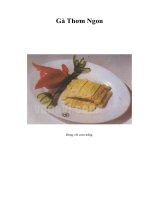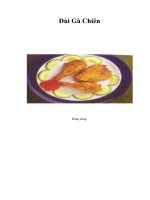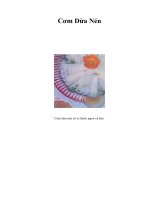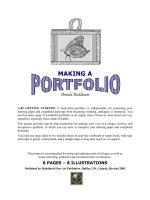Tài liệu Hatching Simple Mountains pdf
Bạn đang xem bản rút gọn của tài liệu. Xem và tải ngay bản đầy đủ của tài liệu tại đây (643.53 KB, 6 trang )
HATCHING
Brenda Hoddinott
F-02 BEGINNER: HATCHING
In this lesson, you outline three simple mountains and add shading with hatching. You create the
four different values with a 2B pencil, by using a combination of the following two techniques:
̇ Vary the density of the hatching lines by drawing them either far apart or close together.
̇ Vary the pressure used while holding the pencil; you press lightly for the light values and
a little harder for darker values.
This lesson is divided into the following two parts:
¬ SKETCHING THREE MOUNTAINS: You sketch three overlapping mountains beginning
with the one that is closest, and working back toward the distant mountain.
¬ ADDING SHADING WITH HATCHING: The farther an object recedes into the distance,
the lighter in value it seems to become. After shading the sky with a very light value, you
then add shading to the mountains with hatching, beginning with the one in the background,
and working toward the foreground, making each value progressively darker.
This project is recommended for artists and aspiring artists of all ages, as well as
home schooling, academic and recreational fine art educators.
6 PAGES – 7 ILLUSTRATIONS
Published by Hoddinott Fine Art Publishers, Halifax, NS, Canada, 2005 (Revised 2006)
Copyright to all articles, images, text, projects, lessons and exercises within this drawing class belong to Brenda Hoddinott and may
not be reproduced or used for any commercial purposes whatsoever without the written permission of Brenda Hoddinott.
Web sites and
2
SKETCHING THREE MOUNTAINS
In this section, you sketch three overlapping mountains beginning with the one that is closest,
and working back toward the distant mountain and the sky. Overlapping is a technique that gives
the illusion of depth in a drawing, and refers to the position of subjects in a composition, when
one visually appears to be in front of another (or others).
1. Outline a horizontal rectangle (similar in shape to mine) as your drawing space.
A horizontal rectangle is often referred to as a landscape format. Suggested sizes include 2
by 4 inches, or 3 by 6 inches.
2. Sketch the outline of the first mountain.
This mountain is in the front, closer to the viewer than the other two.
ILLUSTRATION 02-01
The outline
begins about
three-quarters
of the way
toward the top
of the left side
of the
rectangle, and
meets the
lower side
approximately
three-quarters
of the way
toward the
right.
ILLUSTRATION 02-02
3. Outline a
second
mountain
behind
the first.
Feel free
to draw
your
mountains
either
more
rounded or
more
jagged.
Copyright to all articles, images, text, projects, lessons and exercises within this drawing class belong to Brenda Hoddinott and may
not be reproduced or used for any commercial purposes whatsoever without the written permission of Brenda Hoddinott.
Web sites and
3
4. Add a third mountain that appears to be behind the other two.
ILLUSTRATION 02-03
ADDING SHADING WITH HATCHING
In this section, you begin by shading the sky. Then, you add shading to the mountains with
hatching, beginning with the one in the background, and working toward the foreground, making
each value progressively darker. This shading process creates a component of perspective known
as atmospheric perspective.
Atmospheric perspective (sometimes called aerial perspective) refers to the visual depth created
by various particles in the atmosphere. The farther an object recedes into the distance, the lighter
in value it seems to become, and its edges and forms appear more blurred. Even on a clear day,
your ability to see distant objects is decreased by an assortment of atmospheric components, such
as minuscule particles of dust and/or pollen and/or tiny droplets of moisture. Your vision
becomes even further diminished when the atmosphere is filled with haze, fog, smoke, rain or
snow. Even fairly close-up objects can appear out of focus or almost invisible under certain
conditions.
Shading refers to those parts of a drawing that have values (sometimes called tones), and is used
to give the illusion of depth or three-dimensional reality. Hatching is a classical shading
technique comprised of sets of lines drawn closely together to give the illusion of various values.
Values are the different shades of gray created by varying the density of the lines, and the
pressure used in holding the pencil.
In this section, you use a 2B pencil to render four different values, by combining two techniques:
Vary the density of the hatching lines by drawing them either far apart or close together.
Vary the pressure used while holding the pencil; you press lightly for the light values and a
little harder for darker values.
Copyright to all articles, images, text, projects, lessons and exercises within this drawing class belong to Brenda Hoddinott and may
not be reproduced or used for any commercial purposes whatsoever without the written permission of Brenda Hoddinott.
Web sites and
4
5. Press very lightly with your 2B pencil to draw the lightest hatching lines of the sky.
The lines are far apart and few in number.
ILLUSTRATION 02-04
6. Use an HB pencil to add shading to the mountain in the distance.
This mountain needs to be slightly darker than the sky; so, you need to press a little harder on
your pencil, and also draw a few more hatching lines. However, keep in mind that the two
closer mountains need to be even darker, so be careful not to make this shading too dark.
ILLUSTRATION 02-05
Copyright to all articles, images, text, projects, lessons and exercises within this drawing class belong to Brenda Hoddinott and may
not be reproduced or used for any commercial purposes whatsoever without the written permission of Brenda Hoddinott.
Web sites and
5
7. Add shading to the second mountain with a 2B pencil.
Press a little harder with your pencil, and add lots of hatching lines fairly close together.
ILLUSTRATION 02-06
8. Add shading to the mountain in the foreground with a 2B pencil.
More lines make up the fourth hatching set, and they are much closer together than in the
first three. Also, not much of the white paper is still showing through.
ILLUSTRATION 02-07
Copyright to all articles, images, text, projects, lessons and exercises within this drawing class belong to Brenda Hoddinott and may
not be reproduced or used for any commercial purposes whatsoever without the written permission of Brenda Hoddinott.
Web sites and
6
BRENDA HODDINOTT - BIOGRAPHY
As a self-educated teacher, visual artist, portraitist, forensic artist, and illustrator, Brenda
Hoddinott utilizes diverse art media including graphite, technical pen, colored pencil, chalk
pastel, charcoal, conté crayon, and oil paints.
My philosophy on teaching art is to focus primarily
on the enjoyment aspects while gently introducing
the technical and academic. Hence, in creating a
passion for the subject matter, the quest for
knowledge also becomes enjoyable.
>Brenda Hoddinott<
Born in St. John’s, Newfoundland, Brenda grew up in the small town of Corner Brook. She
developed strong technical competencies with a personal commitment to self directed learning,
and the aid of assorted “Learn to Draw” books. During Brenda’s twenty-five year career as a
self-educated civilian forensic artist, numerous criminal investigation departments have
employed Brenda’s skills, including Royal Canadian Mounted Police and municipal police
departments. In 1992, Brenda was honored with a commendation from the Royal Canadian
Mounted Police, and in 1994, she was awarded a Certificate of Membership from “Forensic
Artists International”.
Her home-based art career included graphic design, and teaching recreational drawing and
painting classes. As supervisor of her community’s recreational art department, Brenda hired and
trained teachers, and designed curriculum for several children’s art programs. In 1998, Brenda
chose to end her eighteen-year career as an art educator in order to devote more time to writing,
drawing, painting, and developing her websites.
Drawspace
incorporates her unique style and innovative approach to
curriculum development. This site offers downloadable and printable drawing classes for
students of all abilities from the age of eight through adult. Students of all ages, levels and
abilities have praised the simple step-by-step instructional approach. This site is respected as a
resource for fine art educators, home schooling programs, and educational facilities throughout
the world.
LEARN-TO-DRAW BOOKS BY BRENDA HODDINOTT
Drawing for Dummies (2003): Wiley Publishing, Inc., New, York, NY, this 336 page book
is available on various websites and in major bookstores internationally.
The Complete Idiot’s Guide to Drawing People (2004): Winner of the Alpha-Penguin
Book of the Year Award 2004, Alpha - Pearson Education – Macmillan, Indianapolis, IN,
this 360 page book is available on various websites and in major bookstores internationally.









